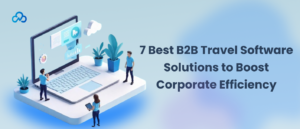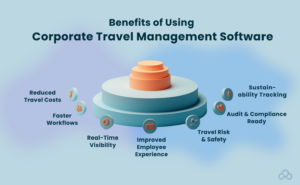7 Best B2B Travel Software Solutions to Boost Corporate Efficiency

Let’s be honest, B2B travel has become a bit of a mess. With tighter budgets, more remote teams, and travel policies that keep shifting, what used to be a fairly routine process now feels like a moving target. If your company is still cobbling things together with spreadsheets, emails, or generic booking apps, you’re probably spending more time managing the process than the trip itself.
That’s where business travel platforms come in.
Built for teams, not individual travelers, these tools help automate approvals, flag non-compliant bookings, and sync seamlessly with finance systems. In short, they turn what used to be chaos into something structured, manageable, and far less stressful.
And while big companies were early adopters, it’s not just the Fortune 500 making the leap. More small and mid-sized businesses are turning to smarter travel technology to save time, tighten control, and gain better visibility into how travel affects their bottom line.
In this guide, we’ll highlight seven of the best options available right now, each one designed by a top travel software development company and trusted by teams that need their travel tools to just work. Whether you’re focused on cutting costs, improving compliance, or simply giving your team a better experience, there’s a corporate travel management software solution here that’s worth a closer look.
What Is B2B Travel Software and Why Does It Matter?
When most people think of booking travel, they picture sites like Expedia or Booking.com. Those work fine if you’re planning a personal getaway, but in a business setting, things get a whole lot more complicated, fast.
You’re not just booking one flight. You’re managing dozens of trips, each with its own approvals, budgets, and rules to follow. That’s where business travel platforms step in, and why they matter so much more than people realize.
Unlike consumer tools, corporate travel management software is built to handle the real mess of business travel. We’re talking about automated workflows, built-in policy enforcement, expense tracking, and even syncing with your HR or finance tools, so the data doesn’t get lost in some spreadsheet no one checks.
It’s really about control. About knowing where your team is, what’s being spent, and making sure everything follows your company’s travel guidelines without someone having to chase down approvals manually.
And it’s not just about convenience either. These tools are evolving fast. We’re seeing features like real-time booking updates, alerts for out-of-policy reservations, and smarter automation that stops problems before they start.
Here’s the kicker: global corporate travel spending is expected to hit $1.4 trillion by 2026. That’s a massive number, and a clear signal that business travel isn’t slowing down any time soon.
So, investing in smart travel technology isn’t just a nice upgrade, it’s a necessity. And when you work with an experienced travel software development company, you’re not just buying software. You’re setting your team up with something that actually makes the process smoother, faster, and way less stressful.
Key Features to Look for in B2B Travel Software
Not all business travel platforms are created equal. While most tools promise to “make booking easier,” the real value shows up when a platform actually reduces headaches, before, during, and after a trip.
So, what should you be looking for in corporate travel management software? Here are the core features that separate a basic booking tool from a solution that actually helps your company move smarter.
Real-Time Booking with Policy Filters
Your team shouldn’t have to guess if a hotel or flight meets company rules. The best platforms show live inventory while applying your travel policies in the background. That way, travelers only see options that are approved, no backtracking, no last-minute approvals.
Automated Expense Reporting
Manual expense tracking is a drain. Great platforms sync bookings with your finance system, generate digital receipts, and tag expenses automatically. Not only does this cut down on paperwork, it also helps finance teams close the books faster.
Multi-Level Approvals (That Don’t Slow You Down)
Let’s face it, some trips need more eyes on them. The right software lets you customize approval flows by team, department, or location, without holding things up. When done right, travel requests move smoothly and stay compliant without adding red tape.
Integrations with Tools You Already Use
A solid travel technology stack should work with what you’ve already got, like SAP, QuickBooks, or your HR platform. Whether it’s syncing employee data or pushing expenses straight into your ERP, integration means fewer errors and less manual work.
Security, Compliance, and Global Readiness
If your team travels internationally, or you’re dealing with audits, don’t overlook compliance. Top tools come with role-based access, GDPR/SOC 2 readiness, and localized tax handling. It’s not just about staying safe; it’s about staying ahead.
Mobile Access That Actually Works
Whether someone’s stuck at the airport or changing plans mid-trip, they need to manage everything from their phone. That means full-feature apps, real-time alerts, and support that doesn’t disappear when you’re on the move.
A good travel software development company won’t just build nice features. They’ll build systems that actually fit into your day-to-day, saving time, reducing risk, and making business travel a lot less chaotic.
7 Best B2B Travel Software Solutions (With Use Cases)
With so many tools on the market, picking the right corporate travel management software can feel like guesswork. That’s why we’ve narrowed it down to seven standout options, each one built by a trusted travel software development company, and each solving real-world problems for teams trying to streamline business travel.
SAP Concur
Best for: Enterprise-level organizations with complex global travel needs.
SAP Concur is one of the most widely adopted business travel platforms for a reason. It combines booking, expense, and invoice management under one roof, and it plays nicely with popular finance systems like Oracle and NetSuite.
It’s packed with features: multi-currency support, mobile expense capture, policy enforcement tools, and even AI-powered fraud detection. For large companies with detailed compliance requirements, it’s a powerhouse.
What stands out: Its ability to scale globally while keeping everything, from taxes to expense workflows, in sync.
Navan (formerly TripActions)
Best for: High-growth teams that want an all-in-one travel and expense platform.
Navan focuses on speed, automation, and user experience. It’s modern, intuitive, and offers one of the slickest mobile apps in the space. Plus, it gives finance teams real-time visibility into travel spend while making bookings super simple for employees.
Whether it’s enforcing travel policies, pulling expense reports, or giving travelers flexible rebooking options, Navan makes things smoother on both ends.
What stands out: Smart automation that learns company preferences and streamlines approvals without added complexity.
TravelPerk
Best for: Small to mid-sized businesses that want flexibility and control.
TravelPerk offers a great mix of ease-of-use and deep functionality. It’s ideal for teams that want to centralize their travel without losing flexibility. You can book flights, trains, hotels, even Airbnb, all through one dashboard.
It also integrates well with accounting tools like Xero and QuickBooks, which makes post-trip reconciliation a breeze.
What stands out: Its flexible cancellation policies (FlexiPerk) and transparent pricing.
Egencia
Best for: Global teams that need structure without sacrificing user experience.
Egencia, backed by American Express Global Business Travel, combines a clean interface with robust enterprise features. It’s ideal for companies that want strong control over policy compliance and travel data, but still want the booking experience to feel modern.
It integrates well with HR and ERP systems, offers global inventory, and supports real-time reporting dashboards for finance leaders.
What stands out: Strong travel policy tools and one of the most globally focused interfaces in the market.
CTM (Corporate Travel Management)
Best for: Companies needing hands-on service and global reach.
CTM isn’t just a software product, it also offers white-glove travel support. This makes it a good fit for companies managing VIP travel or frequent international bookings. Their platform includes smart tools for booking, tracking, and compliance, but also gives you access to real agents when things get complicated.
What stands out: A rare mix of powerful travel technology and live support when your team needs it most.
Itilite
Best for: Teams looking to automate and personalize travel without breaking the bank.
Itilite offers a nice balance between affordability and function. It’s designed to make corporate travel feel less manual by suggesting personalized options for each traveler, while still keeping things under control for finance and operations.
It also includes automated approvals, mobile expense tracking, and real-time policy alerts.
What stands out: Great value for growing teams that want smarter automation baked in.
TripActions Liquid
Best for: Companies that want a tighter grip on expenses.
While technically part of the Navan ecosystem, TripActions Liquid deserves its own mention. It extends the platform into expense management, helping you track every dollar before, during, and after a trip. Teams can issue smart virtual cards, set spending limits, and sync everything with your accounting tools.
What stands out: Real-time expense visibility that makes budget control more proactive, not reactive.
Benefits of Using Corporate Travel Management Software
Investing in the right B2B travel platform is about more than just simplifying bookings. For many companies, it becomes a foundation for operational efficiency, risk reduction, and smarter financial decision-making. Below are some of the most significant advantages of implementing modern corporate travel management software.

Reduced Travel Costs Through Policy Enforcement
Manual oversight often leads to inconsistent travel spending. With a centralized B2B travel software solution, businesses can automate policy compliance, set budget thresholds, and flag out-of-policy bookings before they occur.
Example: A financial services firm using TravelPerk reported a 20% drop in overall travel spend within six months by enforcing pre-trip approvals.
Time Saved Through Automation
Routine tasks like booking approvals, itinerary updates, and expense reporting can be time-consuming if handled manually. Business travel platforms streamline these workflows, reducing human error and freeing up internal resources.
Fact: Companies using automated travel workflows experience 35–45% faster reimbursement cycles, according to internal reports from SAP Concur clients.
Better Visibility and Reporting
Having real-time data on travel expenses, bookings, and compliance makes it easier to identify trends, spot inefficiencies, and make informed decisions. Top-tier B2B travel solutions offer built-in analytics dashboards for finance and operations teams.
Use Case: With ITILITE’s reporting dashboard, a mid-size IT company identified redundant travel routes and consolidated trips, saving $50,000 annually.
Improved Traveler Experience and Safety
Employee satisfaction matters, especially when staff are frequently on the move. Platforms with mobile apps, 24/7 support, and real-time alerts improve the traveler’s experience and ensure their safety.
Additionally, features like traveler tracking and emergency assistance are now standard in most enterprise-grade corporate travel management software.
Centralized Data for Audits and Compliance
Whether you’re preparing for a financial audit or tracking ESG-related metrics, having centralized travel data simplifies compliance. Tools like Egencia and CTM support audit trails, duty-of-care tracking, and tax documentation, features that are especially useful for multinational operations.
Alignment With Sustainability Goals
Many companies now measure business travel’s carbon footprint. Platforms like TravelPerk and Navan offer CO₂ tracking and offsetting features, helping align B2B travel strategies with sustainability initiatives.
Insight: A European tech firm using TravelPerk’s carbon offset program reported a 100% offset rate for internal travel within one year.
Summary
The benefits of adopting corporate B2B travel software go far beyond convenience. From lowering costs and reducing manual work to improving safety and ESG alignment, the right platform becomes a strategic asset, not just an operational tool.
Feature Comparison of the Top 7 B2B Travel Platforms
With so many B2B travel software development company options on the market, it can be tough to tell them apart at a glance. To help, we’ve put together a side-by-side comparison of the seven platforms covered earlier. While each tool brings something unique to the table, this overview should give you a clearer sense of which one fits your organization’s size, complexity, and travel goals.
Note: Features marked as “custom” or “moderate” vary depending on your configuration or plan tier.
At-a-Glance: B2B Travel Software Feature Table
|
Platform |
Best For |
ERP/HR Integrations |
Reporting Tools |
Mobile Access |
Duty of Care Support |
|
SAP Concur |
Large enterprises |
Yes (deep integration) |
Advanced analytics |
✔️ |
✔️ |
|
Navan |
Mid-to-enterprise level |
Yes |
Real-time dashboards |
✔️ |
✔️ |
|
Egencia |
Global organizations |
Yes |
Enterprise-level |
✔️ |
✔️ |
|
TravelPerk |
SMBs and growing teams |
Moderate |
Built-in reports |
✔️ |
Optional |
|
ITILITE |
Cost-focused companies |
Strong |
Smart dashboard |
✔️ |
✔️ |
|
CTM |
Highly customized needs |
Customizable |
Custom setup |
✔️ |
✔️ |
|
Serko Zeno |
APAC-based enterprises |
Yes |
Basic |
✔️ |
✔️ |
Quick Notes
- Integrations: If you rely heavily on SAP, Oracle, or QuickBooks, platforms like SAP Concur and ITILITE tend to offer the smoothest integrations out of the box.
- Mobile Use: All tools listed here provide solid mobile access, but Navan and Serko Zeno stand out for ease of use while on the go.
- Duty of Care: If traveler safety is a top priority, Egencia and CTM offer strong risk management and live tracking features tailored for global operations.
Choosing the right B2B travel platform depends on more than features, it’s about what fits your team’s day-to-day flow. Use this chart as a quick filter, then dig deeper based on what your organization actually needs.
Technical FAQs
Even when the basics are clear, choosing the right corporate travel management software often brings up a few practical questions, especially when you’re dealing with real budgets, real systems, and a team that’s expecting it all to just work. Below are some of the most common questions companies ask during the decision-making process.
Can B2B travel software integrate with our current finance tools?
Yes, most modern business travel platforms are designed with integration in mind. Many connect directly to popular systems like SAP, Oracle, QuickBooks, or even custom-built finance tools. Some offer open APIs, while others have pre-built connectors that make syncing expense data straightforward. Just be sure to bring up integration details early during onboarding, especially if your setup is unique or heavily customized.
How do these platforms enforce travel policies automatically?
The better platforms don’t just list options, they screen them. Thanks to built-in rule engines, they can flag or even block bookings that go against your travel policy. For instance, if an employee tries to book a premium seat when only economy is allowed, the system can either issue a warning, send it for approval, or reject it altogether, based on the rules you’ve set. It keeps everything consistent, without forcing managers to micromanage.
What about global travel, can the system handle different currencies and taxes?
Definitely. Leading travel technology platforms are built with global teams in mind. They support multi-currency bookings, apply regional tax rules (like VAT or GST), and let you customize compliance settings by country. This isn’t just helpful for day-to-day use, it makes audit trails cleaner and financial reporting more accurate across borders.
How long does it take to roll out a new platform?
It really depends on what you’re working with. If you’re going with a cloud-first solution like TravelPerk or Navan and don’t need heavy customization, setup can take as little as a few days. For enterprise-level tools like SAP Concur, especially with deeper integrations and multiple teams involved, a full rollout might take four to eight weeks. The good news? Most vendors walk you through it step by step, offering support from setup to training so nothing gets lost in translation.
The Real Value of Smarter Travel
Let’s be honest, business travel isn’t going away anytime soon. But how companies manage it? That’s already changing.

The old way, chasing approvals through email chains, scrambling over expense reports, juggling bookings in five different apps, it’s slowly being replaced. Today’s business travel platforms are doing more than just speeding things up. They’re making things make sense.
When you bring in the right corporate travel management software, you’re not just looking for convenience. You’re trying to clean up the clutter, get better control over spending, and take the stress off your team. The software takes care of the repetitive stuff, so your people can focus on what they were actually hired to do.
And if you’re working with a smart travel software development company? That’s where it really clicks. You’re not patching together a short-term fix, you’re putting the pieces in place to grow without everything falling apart later.
Because when your systems run smoother, your team moves faster. And in today’s pace, that’s not a luxury, it’s the edge you need.
Do you like to read more educational content? Read our blogs at Cloudastra Technologies or contact us for business enquiry at Cloudastra Contact Us